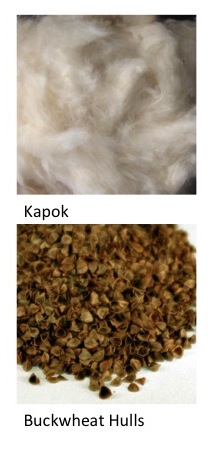Kapok vs. Buckwheat Hulls
Posted by Jay Suthers on May 15th, 2014

Customers frequently contact us with the question, "Kapok or Buckwheat Hulls?" Many of our cushions are available with both fill materials and each material offers distinct pros and cons.
Kapok has been the traditional fill for Zafu meditation cushions for thousands of years. It is a fluffy cotton-like material that comes from the Kapok trees of Asia and in some regions of Southern United States and Central and South America. The Kapok trees grow enormous seed pods that, when mature, burst open to reveal the downy material laden with tiny seeds. The wind catches the fluff and carries the seeds for miles.
Buckwheat Hulls are the outer shell of the
buckwheat grain. This outer shell is too hard to be eaten by humans or animals, so it is a waste product as far as food is concerned.
Both Kapok and Buckwheat Hulls make a great fill material for all kinds of cushions, pillows, and mats. Kapok had been used for floatation devices before the widespread use of plastic foam material.
In recent years, Buckwheat Hulls have become a popular fill for the zafu and other meditation cushions. The reason is that buckwheat hulls conform so well to the shape of the body resulting in a comfortable and stable cushion for meditation. It is similar to sitting in a mound of beach sand and, therefore, can provide a more grounded feel - please excuse the pun.
Let's briefly go over some of the pros and cons for each type of fill:
Kapok
Pros
- It's the traditional fill and has been used for thousands of years.
- Because of its cotton-like nature, it feels softer than buckwheat.
- Though the kapok cushions can flatten with use, they can be revived by squeezing and fluffing up the cushion. This will also restore lift.
- Kapok is light weight compared to Buckwheat Hulls.
Cons
- The level of kapok cannot easily be adjusted - the fibers are blown into the cushion. Removing kapok from a cushion is not recommended and stuffing more kapok into the cushion manually can result in a lumpy cushion with a "Cottage Cheese" look to it.
- The kapok has a spongy but firm feel to it. However, it can be somewhat like sitting on a ball and feel a bit roly poly or wobbly.
- Restuffing a kapok cushion really requires professional equipment - using a yard stick or long wooden dowel will result in uneven areas and lumps.
Buckwheat Hulls
Pros
- Especially with Sage Meditation's Zafus and other meditation cushions, the Buckwheat Hull cushions are adjustable. They each have a zippered opening, which we use to fill the cushions. This opening will allow you to remove and re-add buckwheat hulls to adjust the height and comfort of the cushion.
- Buckwheat hulls conform to the shape of the body and provide a grounded feel.
- Buckwheat hull cushions do not flatten or require fluffing up.
Cons
- Some customers find that Buckwheat Hull cushions to be a bit hard. Just like sitting on sand, it can be a firm surface if you don't have some of your own natural cushion "down there".
- The Buckwheat Hulls make a bit of a scrunching sound when you move around on them.
- Buckwheat Hull cushions weigh about twice as much as kapok cushions.
- The hulls break down after awhile, but are easy to replace or add to through the zippered opening.
The Buckwheat Hull cushions have become increasingly more popular. More than 80% of the Zafu and Cosmic Cushion orders from our customers are for Buckwheat Hull fill. The customers who choose Kapok typically choose this product because they want the traditional cushion. Others have chosen the Kapok because it is a bit more soft to the touch. Again, Kapok is also lighter, which makes it somewhat easier to carry around.
It is best if you can test a few cushions locally before making a purchase, but we stand by our
30-day return policy. We want you to have the best cushion for your need.
Thank you for reading,
Jay
If you would like to comment on this blog or have any questions, please feel free to
Contact Sage Meditation Customer Service.

